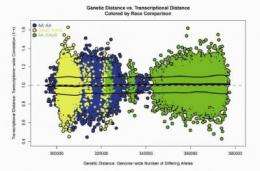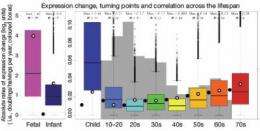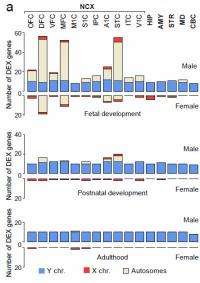Our brains are made of the same stuff, despite DNA differences

Despite vast differences in the genetic code across individuals and ethnicities, the human brain shows a "consistent molecular architecture," say researchers supported by the National Institutes of Health. The finding is from a pair of studies that have created databases revealing when and where genes turn on and off in multiple brain regions through development.
"Our study shows how 650,000 common genetic variations that make each of us a unique person may influence the ebb and flow of 24,000 genes in the most distinctly human part of our brain as we grow and age," explained Joel Kleinman, M.D., Ph.D., of the National Institute of Mental Health (NIMH) Clinical Brain Disorders Branch.
Kleinman and NIMH grantee Nenad Sestan, M.D., Ph.D. of Yale University, New Haven, Conn., led the sister studies in the Oct. 27, 2011 issue of the journal Nature.
"Having at our fingertips detailed information about when and where specific gene products are expressed in the brain brings new hope for understanding how this process can go awry in schizophrenia, autism and other brain disorders," said NIMH Director Thomas R. Insel, M.D.
Both studies measured messenger RNAs or transcripts. These intermediate products carry the message from DNA, the genetic blueprint, to create proteins and differentiated brain tissue. Each gene can make several transcripts, which are expressed in patterns influenced by a subset of the approximately 1.5 million DNA variations unique to each of us. This unique set of transcripts is called our transcriptome – a molecular signature that is unique to every individual. The transcriptome is a measure of the diverse functional potential that exists in the brain.
Both studies found that rapid gene expression during fetal development abruptly switches to much slower rates after birth that gradually decline and eventually level off in middle age. These rates surge again as the brain ages in the last decades, mirroring rates seen in childhood and adolescence, according to one of the studies. The databases hold secrets to how the brain's ever-changing messenger chemical systems, cells and development processes are related to gene expression patterns through development.

For example, if a particular version of a gene is implicated in a disorder, the new resources might reveal how that variation affects the gene's expression over time and by brain region. By identifying even distant genes that may be turning on and off in-sync, the databases may help researchers discover whole modules of genes involved in the illness. They can also reveal how variation in one gene influences another's expression.
Prefrontal cortex
Kleinman's team focused on how genetic variations are linked to the expression of transcripts in the brain's prefrontal cortex, the area that controls insight, planning and judgment, across the lifespan. They studied 269 postmortem, healthy human brains, ranging in age from two weeks after conception to 80 years old, using 49,000 genetic probes. The database on prefrontal cortex gene expression alone totals more than 1 trillion pieces of information, according to Kleinman.
Among key findings in the prefrontal cortex:
- Individual genetic variations are profoundly linked to expression patterns. The most similarity across individuals is detected early in development and again as we approach the end of life.
- Different types of related genes are expressed during prenatal development, infancy, and childhood, so that each of these stages shows a relatively distinct transcriptional identity. Three-fourths of genes reverse their direction of expression after birth, with most switching from on to off.
- Expression of genes involved in cell division declines prenatally and in infancy, while expression of genes important for making synapses, or connections between brain cells, increases. In contrast, genes required for neuronal projections decline after birth – likely as unused connections are pruned.
- By the time we reach our 50s, overall gene expression begins to increase, mirroring the sharp reversal of fetal expression changes that occur in infancy.
- Genetic variation in the genome as a whole showed no effect on variation in the transcriptome as a whole, despite how genetically distant individuals might be. Hence, human cortexes have a consistent molecular architecture, despite our diversity.
Multiple brain regions
Sestan and colleagues characterized gene expression in 16 brain regions, including 11 areas of the neocortex, from both hemispheres of 57 human brains that spanned from 40 days post-conception to 82 years – analyzing the transcriptomes of 1,340 samples. Using 1.4 million probes, the researchers measured the expression of exons, which combine to form a gene's protein product. This allowed them to pinpoint changes in these combinations that make up a protein, as well as to chart the gene's overall expression.

Among key findings:
-- Over 90 percent of the genes expressed in the brain are differentially regulated across brain regions and/or over developmental time periods. There are also widespread differences across region and time periods in the combination of a gene's exons that are expressed.
-- Timing and location are far more influential in regulating gene expression than gender, ethnicity or individual variation.
-- Among 29 modules of co-expressed genes identified, each had distinct expression patterns and represented different biological processes. Genetic variation in some of the most well-connected genes in these modules, called hub genes, has previously been linked to mental disorders, including schizophrenia and depression.
-- Telltale similarities in expression profiles with genes previously implicated in schizophrenia and autism are providing leads to discovery of other genes potentially involved in those disorders.
-- Sex differences in the risk for certain mental disorders may be traceable to transcriptional mechanisms. More than three-fourths of 159 genes expressed differentially between the sexes were male-biased, most prenatally. Some genes found to have such sex-biased expression had previously been associated with disorders that affect males more than females, such as schizophrenia, Williams syndrome, and autism.
More information: The Kleinman study data on genetic variability are accessible to qualified researchers at www.ncbi.nlm.nih.gov/projects/ … y_id5phs000417.v1.p1 , while the gene expression data can be found at www.ncbi.nlm.nih.gov/geo/query … acc.cgi?acc5GSE30272 . In addition, BrainCloud, a web browser application developed by NIMH to interrogate the Kleinman study data, can be downloaded at www.libd.org/braincloud .
















